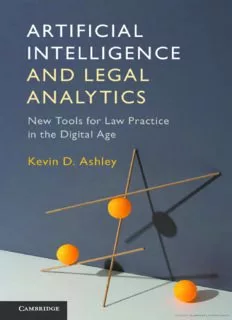
Artificial Intelligence and Legal Analytics: New Tools for Law Practice in the Digital Age PDF
Preview Artificial Intelligence and Legal Analytics: New Tools for Law Practice in the Digital Age
“FM” — 2017/5/31 — 10:36 — page i — #1 artificial intelligence and legal analytics NewToolsforLawPracticeintheDigitalAge Thefieldofartificialintelligence(AI)andthelawisonthecuspofarevolutionthatbegan withtextanalyticprogramslikeIBM’sWatsonandDebaterandtheopen-sourceinforma- tionmanagementarchitecturesonwhichtheyarebased.Today,newlegalapplications arebeginningtoappear,andthisbook–designedtoexplaincomputationalprocesses to non-programmers – describes how they will change the practice of law, specifically byconnectingcomputationalmodelsoflegalreasoningdirectlywithlegaltext,generat- ingargumentsforandagainstparticularoutcomes,predictingoutcomes,andexplaining thesepredictionswithreasonsthatlegalprofessionalswillbeabletoevaluateforthem- selves.Theselegalappswillsupportconceptuallegalinformationretrievalandenable cognitivecomputing,enablingacollaborationbetweenhumansandcomputersinwhich eachperformsthekindsofintelligentactivitiesthattheycandobest.Anyoneinterested inhowAIischangingthepracticeoflawshouldreadthisilluminatingwork. Dr. Kevin D. Ashley isaProfessorofLawandIntelligentSystemsattheUniversityof Pittsburgh,SeniorScientist,LearningResearchandDevelopmentCenter,andAdjunct Professor of Computer Science. He received a B.A. from Princeton University, a JD fromHarvardLawSchool,andPh.D.incomputersciencefromtheUniversityofMas- sachusetts. A visiting scientist at the IBM Thomas J. Watson Research Center, NSF Presidential Young Investigator, and Fellow of the American Association for Artificial Intelligence, he is co-Editor-in-Chief of Artificial Intelligence and Law and teaches in the University of Bologna Erasmus Mundus doctoral program in Law, Science, and Technology. Downloaded from https://www.cambridge.org/core. Faculty of Classics, University of Cambridge, on 03 Nov 2017 at 08:54:17, subject to the Cambridge Core terms of use, available at https://www.cambridge.org/core/terms. https://doi.org/10.1017/9781316761380 “FM” — 2017/5/31 — 10:36 — page ii — #2 Downloaded from https://www.cambridge.org/core. Faculty of Classics, University of Cambridge, on 03 Nov 2017 at 08:54:17, subject to the Cambridge Core terms of use, available at https://www.cambridge.org/core/terms. https://doi.org/10.1017/9781316761380 “FM” — 2017/5/31 — 10:36 — page iii — #3 Artificial Intelligence and Legal Analytics new tools for law practice in the digital age KEVIN D. ASHLEY UniversityofPittsburghSchoolofLaw Downloaded from https://www.cambridge.org/core. Faculty of Classics, University of Cambridge, on 03 Nov 2017 at 08:54:17, subject to the Cambridge Core terms of use, available at https://www.cambridge.org/core/terms. https://doi.org/10.1017/9781316761380 “FM” — 2017/5/31 — 10:36 — page iv — #4 UniversityPrintingHouse,CambridgeCB28BS,UnitedKingdom OneLibertyPlaza,20thFloor,NewYork,NY10006,USA 477WilliamstownRoad,PortMelbourne,VIC3207,Australia 4843/24,2ndFloor,AnsariRoad,Daryaganj,Delhi–110002,India 79AnsonRoad,#06-04/06,Singapore079906 CambridgeUniversityPressispartoftheUniversityofCambridge. ItfurtherstheUniversity’smissionbydisseminatingknowledgeinthepursuitof education,learning,andresearchatthehighestinternationallevelsofexcellence. www.cambridge.org Informationonthistitle:www.cambridge.org/9781107171503 doi:10.1017/9781316761380 ©KevinD.Ashley2017 Thispublicationisincopyright.Subjecttostatutoryexception andtotheprovisionsofrelevantcollectivelicensingagreements, noreproductionofanypartmaytakeplacewithoutthewritten permissionofCambridgeUniversityPress. Firstpublished2017 PrintedintheUnitedStatesofAmericabySheridanBooks,Inc. AcataloguerecordforthispublicationisavailablefromtheBritishLibrary. LibraryofCongressCataloging-in-PublicationData ISBN978-1-107-17150-3Hardback ISBN978-1-316-62281-0Paperback CambridgeUniversityPresshasnoresponsibilityforthepersistenceoraccuracy ofURLsforexternalorthird-partyinternetwebsitesreferredtointhispublication anddoesnotguaranteethatanycontentonsuchwebsitesis,orwillremain, accurateorappropriate. Downloaded from https://www.cambridge.org/core. Faculty of Classics, University of Cambridge, on 03 Nov 2017 at 08:54:17, subject to the Cambridge Core terms of use, available at https://www.cambridge.org/core/terms. https://doi.org/10.1017/9781316761380 “FM” — 2017/5/31 — 10:36 — page v — #5 ForAlida,forever Downloaded from https://www.cambridge.org/core. Faculty of Classics, University of Cambridge, on 03 Nov 2017 at 08:55:23, subject to the Cambridge Core terms of use, available at https://www.cambridge.org/core/terms. https://doi.org/10.1017/9781316761380 “FM” — 2017/5/31 — 10:36 — page vi — #6 Downloaded from https://www.cambridge.org/core. Faculty of Classics, University of Cambridge, on 03 Nov 2017 at 08:55:23, subject to the Cambridge Core terms of use, available at https://www.cambridge.org/core/terms. https://doi.org/10.1017/9781316761380 “FM” — 2017/5/31 — 10:36 — page vii — #7 Contents Listofillustrations pagexv Listoftables xxi Acknowledgments xxiii parti computationalmodelsoflegalreasoning 1 1 IntroducingAI&LawandItsRoleinFutureLegalPractice 3 1.1. Introduction 3 1.2. AI&LawandthePromiseofTextAnalytics 4 1.3. NewParadigmsforIntelligentTechnologyinLegalPractice 6 1.3.1. FormerParadigm:LegalExpertSystems 8 1.3.2. AlternativeParadigms:ArgumentRetrievalandCognitive Computing 11 1.3.3. TowardtheNewLegalApps 14 1.4. WhatWatsonCanandCannotDo 14 1.4.1. IBM’sWatson 15 1.4.2. QuestionAnsweringvs.Reasoning 18 1.4.3. IBM’sDebaterProgram 23 1.4.4. TextAnalyticToolsforLegalQuestionAnswering 27 1.4.5. SourcesforTextAnalyticTools 30 1.5. AGuidetoThisBook 31 1.5.1. PartI:ComputationalModelsofLegalReasoning 32 1.5.2. PartII:LegalTextAnalytics 33 1.5.3. PartIII:ConnectingComputationalReasoningModels andLegalTexts 34 1.6. ImplicationsofTextAnalyticsforStudents 35 vii Downloaded from https://www.cambridge.org/core. University of Florida, on 03 Nov 2017 at 09:05:57, subject to the Cambridge Core terms of use, available at https://www.cambridge.org/core/terms. https://doi.org/10.1017/9781316761380 “FM” — 2017/5/31 — 10:36 — page viii — #8 viii Contents 2 ModelingStatutoryReasoning 38 2.1. Introduction 38 2.2. ComplexitiesofModelingStatutoryReasoning 39 2.2.1. SemanticAmbiguityandVagueness 39 2.2.2. SyntacticAmbiguity 40 2.3. ApplyingStatutoryLegalRulesDeductively 42 2.3.1. RunningaNormalizedVersiononaComputer 43 2.3.2. PredicateLogic 44 2.3.3. SyntacticAmbiguityasDesignConstraint 45 2.3.4. TheBNAProgram 47 2.3.5. SomeProblemsofTranslatingStatutesintoPrograms 48 2.4. TheComplexityofStatutoryInterpretationandtheNeedfor Arguments 52 2.4.1. AStepwiseProcessofStatutoryInterpretation 53 2.4.2. OtherSourcesofLegalIndeterminacy 54 2.5. ManagementSystemsforBusinessRulesandProcesses 56 2.5.1. BusinessProcessExpertSystems 56 2.5.2. AutomatingBusinessProcessCompliance 60 2.5.3. RequirementsforaProcessComplianceLanguage 62 2.5.4. ConnectingLegalRulesandBusinessProcesses 65 2.5.5. ExampleofBusinessProcessComplianceModeling 68 2.6. RepresentingStatutoryNetworks 70 3 ModelingCase-basedLegalReasoning 73 3.1. Introduction 73 3.2. RelationshipofLegalConceptsandCases 74 3.2.1. TheLegalProcess 74 3.2.2. TheLegalProcessIllustrated 75 3.2.3. RoleofLegalConcepts 76 3.3. ThreeComputationalModelsofLegalConceptsandCases 77 3.3.1. PrototypesandDeformations 78 3.3.2. DimensionsandLegalFactors 81 3.3.3. Exemplar-basedExplanations 93 3.4. TeleologicalModelsofCase-basedLegalReasoning 97 3.5. AnApproachtoModelingTeleologicalReasoning 100 3.5.1. TeleologyinTheoryConstruction 101 3.6. DesignConstraintsforCognitiveComputingwithCase-based ModelsofLegalReasoning 104 4 ModelsforPredictingLegalOutcomes 107 4.1. Introduction 107 4.2. ANearestNeighborApproachtoAutomatedLegalPrediction 108 Downloaded from https://www.cambridge.org/core. University of Florida, on 03 Nov 2017 at 09:05:57, subject to the Cambridge Core terms of use, available at https://www.cambridge.org/core/terms. https://doi.org/10.1017/9781316761380 “FM” — 2017/5/31 — 10:36 — page ix — #9 Contents ix 4.3. IntroductiontoSupervisedMachineLearning 109 4.3.1. MachineLearningAlgorithms:DecisionTrees 110 4.4. PredictingSupremeCourtOutcomes 111 4.4.1. FeaturesforPredictingSupremeCourtOutcomes 112 4.4.2. Applying Supervised Machine Learning to SCOTUS Data 112 4.4.3. EvaluatingtheMachineLearningMethod 113 4.4.4. MachineLearningEvaluationMeasuresandResults 114 4.5. PredictingOutcomeswithCase-basedArguments 114 4.5.1. PredictionwithCATO 115 4.5.2. Issue-basedPrediction 115 4.5.3. IBP’sPredictionAlgorithm 117 4.5.4. EvaluatingIBP’sPredictions 119 4.6. PredictionwithUnderlyingValues 121 4.7. PredictionbasedonLitigationParticipantsandBehavior 123 4.8. PredictioninCognitiveComputing 125 5 ComputationalModelsofLegalArgument 127 5.1. Introduction 127 5.1.1. AdvantagesofCMLAs 128 5.2. TheCarneadesArgumentModel 129 5.3. AnExtendedExampleofaCMLAinAction 131 5.3.1. FamilyLawExamplewithCarneades 132 5.3.2. ArguingwithDefeasibleLegalRules 134 5.3.3. IntegratingArguingwithCasesandRules 135 5.4. ComputationalModelofAbstractArgumentation 139 5.5. HowCMLAsComputeWinnersandLosers 141 5.5.1. ResolvingConflictingArgumentsaboutFacts 142 5.5.2. ResolvingConflictingArgumentsaboutValues 143 5.5.3. ResolvingConflictingArgumentsaboutLegalRules 144 5.6. How Practical are Computational Models of Legal Argument? 144 5.6.1. RoleofProofStandardsinCMLAs 145 5.6.2. IntegratingProbabilisticReasoningintoCMLAs 147 5.7. ValueJudgment-basedArgumentativePredictionModel 149 5.7.1. VJAPDomainModel 150 5.7.2. VJAPValuesUnderlyingTradeSecretRegulation 151 5.7.3. VJAPArgumentSchemes 154 5.7.4. VJAP’sArgument-basedPredictions 156 5.7.5. VJAPProgramEvaluation 158 5.8. ComputationalModelofEvidentiaryLegalArgument 160 5.9. ComputationalModelsofLegalArgumentasaBridge 164 Downloaded from https://www.cambridge.org/core. University of Florida, on 03 Nov 2017 at 09:05:57, subject to the Cambridge Core terms of use, available at https://www.cambridge.org/core/terms. https://doi.org/10.1017/9781316761380
Description: